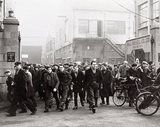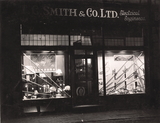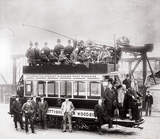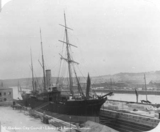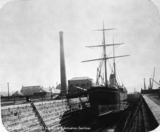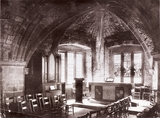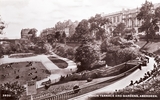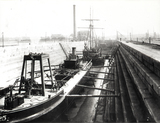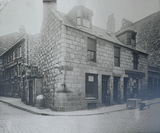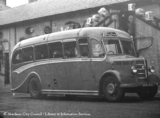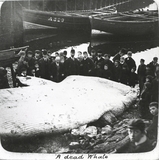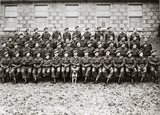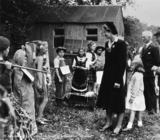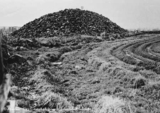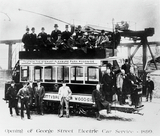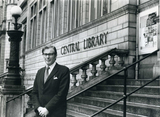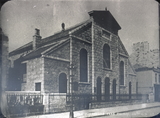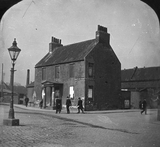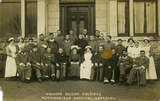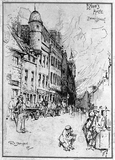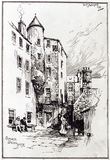|
Quick Search
|
Search Results
You searched for: More Like: 'Details of grant for repair'
509 items
items as
Hall Russell shipbuilders
6 Hall Russell, Ship Builders, Marine Place c. 1950s/60s. Note the main office is off to the right. The entrance at the top of the stairs is to the loft, where scale drawing and templates were drafted. The shipwrights department was on the ground floor to the south of this building.
[Many thanks to Stanley Bruce for providing us with correct details on the building layout.] T. C. Smith and Co., Electrical Engineers
43 Shop frontage of T. C. Smith and Co., Electrical Engineers
T.C. Smith & Co. first appear in the Aberdeen Directory for 1913/14 when they are listed as electrical, automobile and power engineers. They had garage space for over 200 cars and eight private lockups, and were open day and night, including Saturday.
The garage, showrooms and office were at 21-25 Bon-Accord Street; their repair and body building shops were at 20-32 Gordon Street. In 1921-22, they had other premises at 18 Bon-Accord Street, and these are shown in the photograph. The windows have a display of all sorts of electrical equipment including lamps, heaters, radios and Hoovers.
The company would appear to have gone out of business around 1943, because in 1946, Scottish Motor Tractor Co. Ltd had taken over their Bon-Accord premises. Woodside electric tram
137 The inaugural procession on 23rd December 1899 for the electrification of the Woodside tram route, the first in Aberdeen to be modernised.
Lord Provost John Fleming is at the helm, with Tramways Convener Alexander Wilkie standing next to him, and Councillor Alexander Glass has his foot on the platform.
Next to Fleming and Wilkie, and above Glass, appears to be Alexander Lyon, provost between 1905-1908. Baillie James Taggart, also later to be provost, is the right-most figure in the back row on the roof of the car. Two to the left of Taggart may be James Walker, provost between 1903-1905.
James Alexander Bell, City Electrical Engineer for Aberdeen in the late 19th and early 20th centuries, is the bowler hatted figure on the stairs above Lord Provost Fleming.
This inauguration is detailed in an article titled 'Electric tramways in Aberdeen: Opening of Woodside section' in the Aberdeen Journal of 25th December 1899, page 7. It details the celebratory tram trip shown here and a luncheon in the Town and County Hall that followed. Dry Dock, Albert Basin
334 A large dry dock was built in the Albert Basin in 1885 for the repair and overhaul of ships. It was demolished in 1924-27 to make way for the covered fish market. Dry Dock in Albert Basin
360 A large dry dock for the repair and overhauling of ships was opened at the eastern end of the Albert Basin in 1885. It was demolished in 1924-27 to make way for the covered fish market. St. Mary's Chapel, St. Nicholas Church
366 A photograph of St. Mary's Chapel at St. Nicholas Church in around 1898.
Historic Environment Scotland's listed building information suggests this lower church was built in 1438. It was part of the 15th century expansion of St. Nicholas and located to the east of the then existing building. The main church was subsequently expanded eastwards over it.
Work was completed on the crypt in around 1507 and it was dedicated to the Virgin as Our Lady of Pity, from which derives the various names it has been known over the years; Pity Vault, the Cell of Our Lady of Pity, and St. Mary's Chapel.
The space has served many purposes since its creation and seen a number of renovations. It has been a general storehouse for sundry municipal items, including the gibbet, a plumber's shop, a public soup kitchen, a meeting place of the presbytery of Aberdeen, and a regular church.
More can be read about the chapel in Old Landmarks of Aberdeen (1885) by G. Gordon Burr and Alex. M. Munro, The Story of St. Mary's Chapel: The Ancient "Lower Church" or Crypt of St. Nicholas (1935) by The Rev. J. G. Grant Fleming and in the history section of the St. Nicholas Church website. Gala and Heather Day in the Duthie Park
395 This Adelphi Series postcard shows the Gala Day taking place in Duthie Park on 21st August 1915.
The Gala in Duthie Park and the accompanying Heather Day were both organised to raise funds for the Aberdeen Royal Infirmary.
The Gala Day is one of largest events ever to take place at the park. It was estimated that between 25,000 and 26,000 people attended. Tickets cost 6 pence (6d) for general admission and 2s 6d for carriages or motor cars.
Within the park there was an elaborate programme of entertainment and refreshments organised. Details of the programme were published in a 32 page booklet prior to the event. Upwards of 1,300 people took part in the programme.
Gates to the park opened at 3pm and the event officially commence at 3pm with a grand military parade. Lieut-Colonel A. H. Leith of Glenkindie, Garrison Commander, and Lord Provost James Taggart "took the salute" opposite the Hygiea statue.
The Gala and Heather Day were organised by a distinct committee; Taggart was its president and Alexander Findlay, Superintendent of Cleansing, was its chairman. Councillor H. J. Gray was the secretary and treasurer and Mr John Lints was his assistant. There were also conveners and secretaries for various sub-committees concerned with aspects like entertainment and refreshments.
There was a wide range of entertainment organised for within the park including singing, dancing, gymnastic displays, musical drill, motor cycle gymkhana and bayonet fighting. Various platforms saw performances from acts such as a company lead by D. M. Kinghorn, pierrots directed by Minnie Mearns, Dan Williams, and W. A. Craig's operatic choir. Charles Soutar lead a 500 strong choir of children from the city's public schools.
Practically all naval and military units present in the city were represented at the event and individuals from many of them took part in the sporting competitions. The day also included a 5-a-side football and tug of war competition. Preliminary matches for these took place prior to the day at Pittodrie Park.
The Gala Day was filmed and this was later shown as part of a special programme at the Picture House on Union Street from the 25th of the month.
Over £500 was taken at the gates for the event. Entertainment and refreshments within further increased the figure raised.
Heather Day itself generated another £474. This involved over 1,500 vendors going around all parts of the city selling sprigs of the plant. The sale started on the afternoon of the Friday and continued all through Saturday. Entertainment venues throughout the city were also visited.
The vendors were primarily young women and members of organisations like the boys brigade. Stores present in all areas of the city were replenished from a central depot at 173a Union Street. This in turn was supplied by the cleansing department buildings in Poynernook Road, where the preceding week had seen 200,000 sprigs prepared for sale. Peterhead, Inverurie, Ellon and Banchory organised their own Heather Days for the same fund.
The sum taken from both the Gala and the Heather Day was estimated at considerably over £1,000.
See the report in the Aberdeen Journal, Monday 23rd August 1915 page 8, for further details about the occasion. Union Terrace and Gardens
412 A postcard image showing Union Terrace Gardens in the centre of Aberdeen.
There are a couple of notable features that might be able to help date the image: there is no bandstand present and the lower, central area in this image is still in the older lay-out with wide dividing paths.
The removal of the bandstand and change of lay-out may have been carried at around the same time. A minute from an Aberdeen Town Council meeting of 21st September 1931, detailing a recommendation from the Links and Parks Committee to the full Council, reads as follows:
"The Committee had before them a report by the Superintendent of the City Parks, in which he points out that he has had the bandstand in Union Terrace Gardens examined, that it is in a bad state of repair, and that he has been informed that the cost of repairing the worn-out parts would be almost equal to the cost of a new stand. He further states that the bandstand has not been used for some years, owing to the noise from the adjoining railway interfering with the performances, and suggests that the stand should be removed, the site and surrounding pathways levelled, covered with soil and sown with grass seed. If this were done, the playing area would be increased by 1,407 square yards, as shown coloured yellow on the plan herewith submitted, thereby giving greater facilities to the large number of children who frequent the Gardens.
"The Committee approved of the report, and beg to recommend that the Council should grant authority to the Superintendent of Parks to have the bandstand removed and the other work carried out as proposed." (Minutes and Proceedings of Town Council, City of Aberdeen, 1930-1931, page 660.
The full Council approved this recommendation from the Links and Parks Committee. In light of this information, the image may date from relatively shortly after September 1931. After the bandstand has been removed but before the ground had been leveled and sown as a single larger grass lawn. The Dry Dock at Albert Basin
466 The Dry Dock for the repair and overhauling of steamships was opened at the eastern end of the Albert Basin in 1885. It was demolished in 1924-27 to make way for an extension of the covered fish market. Belmont Street
798 This photograph shows the old corner of Belmont Street and Gaelic Lane.
The building on the far left is the Gaelic Free Church. It was opened for worship on 30th August 1795 and in time gave its name to the lane. It was used for the services of Aberdeen's Gaelic congregation until 1882.
The congregation moved and the building was sold to Messers G. and W. Fraser, printers, who owned adjoining premises. They replaced the old church frontage with the more business like façade that can be seen in this photograph.
See the entry for St. Columba United Free Church in Alexander Gammie's Churches of Aberdeen (1909) for more details.
A sign for George Cowie, a hairdressers, is prominently visible at number 4 around the corner on Belmont Street. HUU432, a Bedford OB
864 This image shows HUU432, a Bedford OB coach parked outside Seafield Garage in Cullen. Notice the extensive array of petrol pumps in the background, with such examples as "National Benzone" and "Power".
The vehicle was owned and operated by Donald Grant. Of solid construction, it no doubt covered many hundreds of miles in its journeys through the North-East.
Seafield Garage was owned by John Lawrence, who was another bus operator in the town.
(Many thanks to Dr Mike Mitchell and Peter Findlay for additional information about this image.) A Dead Whale
868 Crowds gathered round a dead whale, with fishing boats (A329) in the background.
Correspondent Ed Fowler suggests that this photograph shows the "Nairn whale".
Initially wrongly identified at the time as a blue whale, it was actually a sei whale (Balaenoptera Borealis), one of the 4th-largest balaenopterid.
The whale stranded at Nairn on 18th December 1884 and was subsequently purchased by Mr Davidson, fish-dealer, Aberdeen. The whale was then towed by the tug Granite City on 2nd February 1885.
The Evening Express from Wednesday 4th February 1885 provides more details about the operation:
"This was accordingly done about five o'clock yesterday afternoon by the tug Granite City, and the leviathan was successfully placed on the waggons which had been provided for the purpose. Suspended in mid-air, the whale presented a remarkable spectacle, its huge proportions being displayed to full advantage. The task of placing it on the huge waggons by which it was conveyed to its destination proved a very laborious and onerous one, and occupied a large staff of men from four o'clock in the afternoon till midnight. Ultimately, the leviathan stretched upon the waggons, and the horses - numbering about two dozen - being attached, the unusual procession proceeded on its way to the Recreation Grounds [Queens Links]. The quay was literally besieged by a crowd which swelled in proportions as time wore on, and whose enthusiasm the disagreeable odour which proceeded from the whale was wholly unable to quench. [About] four o'clock this afternoon, after many difficulties had been encountered and overcome, the whale reached its destination - the Recreations Grounds - where it now lies. As before stated, a very strong smell is felt in the vicinity of the carcase, and the sanitary inspector has brought the matter under the notice of the Public Health Committee".
Ed Fowler adds that "The Landing was a difficult operation as it can reach 19.5M (64-ft) long and weighing as much as 28-Tons. An attempt to haul it from the water at Fittie (Perhaps Alexander Hall's Slipway) with Horses failed and so it was Towed into the harbour to the North Lock Sheer-legs (a lifting system) at the North Lock, Waterloo Quay and hoisted in mid-air with a tackle around the Tail, then placed on a series of Wagons and then dragged by 24 Horses and a crowd of Men to the Recreation Grounds (Queens Links), for Public Exhibition."
Stoneywood Works Home Guard
943 Stoneywood Works Home Guard.
Back Row: Unknown, Unknown, Charlie Thomson, Hector Emslie, Unknown, Bill Irvine, Ed Coutts, John Reid, Jim Smith, Alick Duncan (engineer), Dick Grant, A. Kilgour.
3rd Row: Ralph Davidson, Bob Lawrence, Arthur Smart, Ed McDonald, John Menzies, Bill Kane, Alfred McPherson, Harry Duncan, A. Baigrie, Tom Mitchell, Bill Davidson, Alex Robb, Jim McLean, Bill Denholm, George Sangster (sawmiller).
2nd Row: Gordon Wilson, Jim Davidson, Jim Ross, Unknown, Andy Lawson, Charles Esson, Frank Rundle, Bill Bartlett, Alick Duncan (cutting & rolling), Neil Littlejohn, Bert Campbell, Willie Robbie, Bill Forbes, David Findlater.
Front Row: Bill Thomson, Val Michie, Bill Ross, Jack Beveridge, Bill Kitson, Harry Jordan, Jim Murray, Cozens Hardy, Jack Stewart, Jim Duncan, Bert Spence, Bill Pirie, John Sutherland, Alick Davidson, Bill Wright. Flower show, Culter
1004 Flower show, Culter, 11th August 1945, with Lady Grant (later Lady Tweedsmuir). Cults Cairn
1040 Cults Cairn. This round cairn is scheduled as an ancient monument and is probably around 4,000 years old. It was originally one of three but the other two were carted away in December 1892 so that the stones could be used to repair damage to the banks of the River Dee after the massive flooding caused by the 'Muckle Spate'. At this time (1930's) the cairn was in a rural area, but it is now surrounded by a modern housing development in the area between Cults and Bieldside, 3-4 miles west of Aberdeen. It is about 20 metres in diameter and about 5 metres high on a crest overlooking the Dee valley. There was much concern in the late 1970's that the stones were being removed to create paths and rockeries. George Street Electric Tram Service
1069 A photograph of the inaugural procession on 23rd December 1899 for the electrification of the Woodside tram route, the first in Aberdeen to be modernised.
This copy of the image has been labelled as the "Opening of George Street Electric Car Service - 1899." The trams would have travelled from Aberdeen city centre to Woodside along St. Nicholas Street and George Street.
Lord Provost John Fleming is at the helm, with Tramways Convener Alexander Wilkie standing next to him, and Councillor Alexander Glass has his foot on the platform.
Next to Fleming and Wilkie, and above Glass, appears to be Alexander Lyon, provost between 1905-1908. Baillie James Taggart, also later to be provost, is the right-most figure in the back row on the roof of the car. Two to the left of Taggart may be James Walker, provost between 1903-1905.
James Alexander Bell, City Electrical Engineer for Aberdeen in the late 19th and early 20th centuries, is the bowler hatted figure on the stairs above Lord Provost Fleming.
This inauguration is detailed in an article titled 'Electric tramways in Aberdeen: Opening of Woodside section' in the Aberdeen Journal of 25th December 1899, page 7. It details the celebratory tram trip shown here and a luncheon in the Town and County Hall that followed.
Another, clearer version of this image can be found on this website (image reference: A43_14). Dunecht Smiddy
1146 Blacksmiths in the smiddy at Dunecht. This shop appears to have been fairly busy, employing as it did, 3 blacksmiths. They were called upon for all sorts of metal related jobs. All the tools of the trade can be noted, including 2 anvils for hammering and a main furnace (centre of picture). All 3 blacksmiths are seen here wearing leather aprons, which protected them from the hot flying sparks. No industrial glasses were in use however at this time, and the traditional flat bonnet is still the norm.
Correspondent David Christie has identified the blacksmith on the left as James Stephenson Smith, his great grandfather. David explains that Smith worked as a blacksmith for Dunecht Estate from 1925 to 1929 and so this dates the photograph to this period. His great grandfather also worked at other properties belonging to the estate, such as renovations of Dunnottar Castle. Smith had to give up working as a Blacksmith after breaking his leg in a fall while working there.
He subsequently worked as a driver for the Dunecht Garage, which ran buses at the time, and later for the W. Alexander & Sons bus operating firm.
There is an article about this image by Hilary Simpson in the Evening Express of 17 September 1986. It details the memories of readers Margaret Skene and John Gray. Margaret's grandfather was Alexander Innes, the figure in the middle. On the right is Bill Innes, a son of Alexander. They are said to have run the smiddy with the assistance of James Smith.
The article also explains that the image was originally a postcard. One of a series detailing the various trades active on the Dunecht estate of Lord Cowdray.
(Many thanks to David for getting in touch and providing additional information and making us aware of the newspaper article.) Peter Grant, City Librarian 1972-1989
1420 Peter Grant was City Librarian from 1972 until 1989 and is seen here on the steps of the Central Library on Rosemount Viaduct in 1976.
The wrought iron lamp standards topped by large globes were originally designed to hold gas lights. These beacons were only re-wired and lit again in the 1970s, following the wartime blackout. At the same time the "Central Library" inscription appeared giving the building more visibility.
Image copyright of Aberdeen Journals. Old Bon Accord United Free Church
1526 A photograph of the Bon Accord Church that was located on Union Terrace. The building was previously known as Union Terrace Chapel.
In 1827 a number of the Trinity Chapel congregation split off after unsuccessfully supporting Rev. Gavin Parker, then working in Dundee, as a candidate for the then vacant ministry.
The new congregation and Parker purchased Union Terrace Chapel from a struggling Baptist congregation in 1828. It opened as a Presbyterian place of worship with a service on 27th July 1828.
For some years it operated as a chapel of ease before an reformist Act of the General Assembly was passed that erected chapels of ease into parishes quoad sacra. The building then became known as Bon Accord Church.
During the ministry of Rev. Hector M. Adam, the Bon Accord United Free Church congregation sold this Union Terrace building to the Aberdeen School Board and had new church buildings constructed on Rosemount Viaduct. These new buildings opened on 3rd September 1896 and still house an active congregation today.
The building on Union Terrace appears to have served as School Board, and possibly Aberdeen County Council, offices before being demolished at an unknown date during development to the street.
For more details on this building and the Bon Accord congregation, please see The Churches of Aberdeen by Alexander Gammie (1909, page 92) and Bon-Accord United Free Church, Aberdeen: a Retrospect of 100 Years 1828-1928 (1928). Both books are available to consult at Aberdeen Local Studies. Portland Street at the junction with Wellington Road
1533 A photograph showing the house that was located at the junction of Portland Street and Wellington Road. It can be seen on the Ordnance Survey 1867 Aberdeen town plan, sheet LXXV.15.3.
This image looks north and gives a good view of the building that is thought to have once been the home of Provost George Auldjo of Portlethen (1756-1806). He followed his father, John Auldjo, in running the brick and tiles works in the Clayworks, located to the rear of this house.
The brick and tile works exploited the large amount of clay in the area. By the late 1860s the clay pits were ceasing to be worked. The Clayhills area was consequently leased out for yards and works of various kinds.
The building visible on the right is likely the preserved provision works which was active for only one or two years before moving to South Mount Street.
This house was demolished, and the area radically altered, with the road and railway improvement scheme that finished in 1904. This was carried out by the railway companies as part of the Joint Station extension scheme.
The improvements saw the construction of the lower part of South College Street, which would run through the Clayhills area.
For more details on the Clayhills brick and tile works and the roadworks see G. M. Fraser's article 'Affleck Street and the Clayhills' in The Press and Journal, 16th July 1926, page 4 and the article 'Ferryhill Street Improvements' in The Aberdeen Daily Journal, 24th October 1904, page 4. Wounded Belgian Soldiers, Morningfield Hospital
1747 Morningfield was originally a hospital for those with incurable diseases. Founded in 1857, it was located in Belleview House in the Denburn. In 1882 the Town Council bought the property as part of the development of Rosemount Viaduct. Consequently the hospital authorities bought land and erected new hospital buildings to the west of the city centre. The hospital retained the name Morningfield, also given to the road running past it, and was opened in September, 1884.
The Aberdeen Journal reports that soon after the outbreak of the First World War the Committee of Management of Morningfield Hospital offered, in case of need, to accommodate 30 of the sick or wounded. At the urgent request of military authorities 40 British and Belgian wounded soldiers were admitted to the hospital. This photograph is a group portrait of some of the wounded Belgian soldiers during the war. The image was kindly lent to the library by Arlene Grant whose grandfather was a Belgian soldier treated at Morningfield.
Supplying the hospital during wartime was a challenge and appeals were made to the generosity of the locals: "The Belgian soldiers are very dependent on vegetables and fruit," reported the Aberdeen Journal, "and as the hospital garden is already depleted the matron would be grateful for further supplies. Other articles urgently required are fouls, rabbits, eggs, coffee, cakes and jam". Aberdeen Corporation's Electricity Works
1754 The turbine hall of Aberdeen Corporation's Electricity Works, corner of Crown Street and Millburn Street. Hydraulic power was obtained via a special water intake from the River Dee near Stell Road.
Correspondent Ed Fowler flagged up that the report for a 1907 visit to the works by the Institute of Mechanical Engineers is available to read online. It contains an interesting section with details of the switchboards visible in this image:
"Switchboards.- The electric light and traction switchboards, which run along the south wall for about two-thirds of its length, stand in line with one another on a raised gallery of cast-iron columns and girders supporting a glass fireproof floor about 12 feet above the engine-floor level. The glass floor in the gallery not only serves as an insulator, but also allows a certain amount of light to pass into the area immediately underneath. Both boards are of white marble, the lighting board having been supplied by Messrs. Siemens Bros. and Co., while the traction board of their ordinary standard type was supplied by the British Westinghouse Co." Byron's House
1762 Print of Byron's House, Broad Street. Lord Byron lived in No.64 with his mother when he was a pupil at the Old Grammar School in Schoolhill.
This sketch is by Aberdeen born Robert Douglas Strachan (1875-1950) who went on to become an acclaimed stained-glass artist. See his Oxford Dictionary of National Biography entry for details of his life and career. Victoria Lodging House
1763 Victoria Lodging House. Provost Skene's House, Broad Street. Dating from 1545, Provost Skene's House, also known as Cumberland House, after the Duke of Cumberland who stayed there in 1746. In the 19th century it was known as the Victoria Lodging House. It was in danger of demolition, but for the timely intervention of the Queen Mother in 1938. It was restored after the war.
This sketch is by Aberdeen born Robert Douglas Strachan (1875-1950) who went on to become an acclaimed stained-glass artist. See his Oxford Dictionary of National Biography entry for details of his life and career. |



